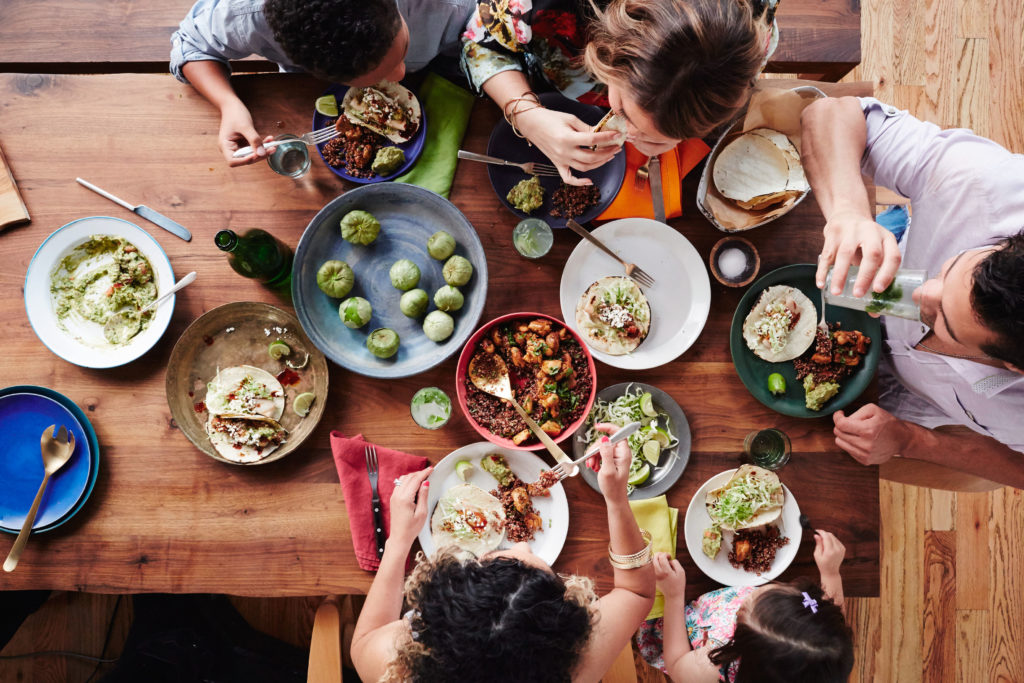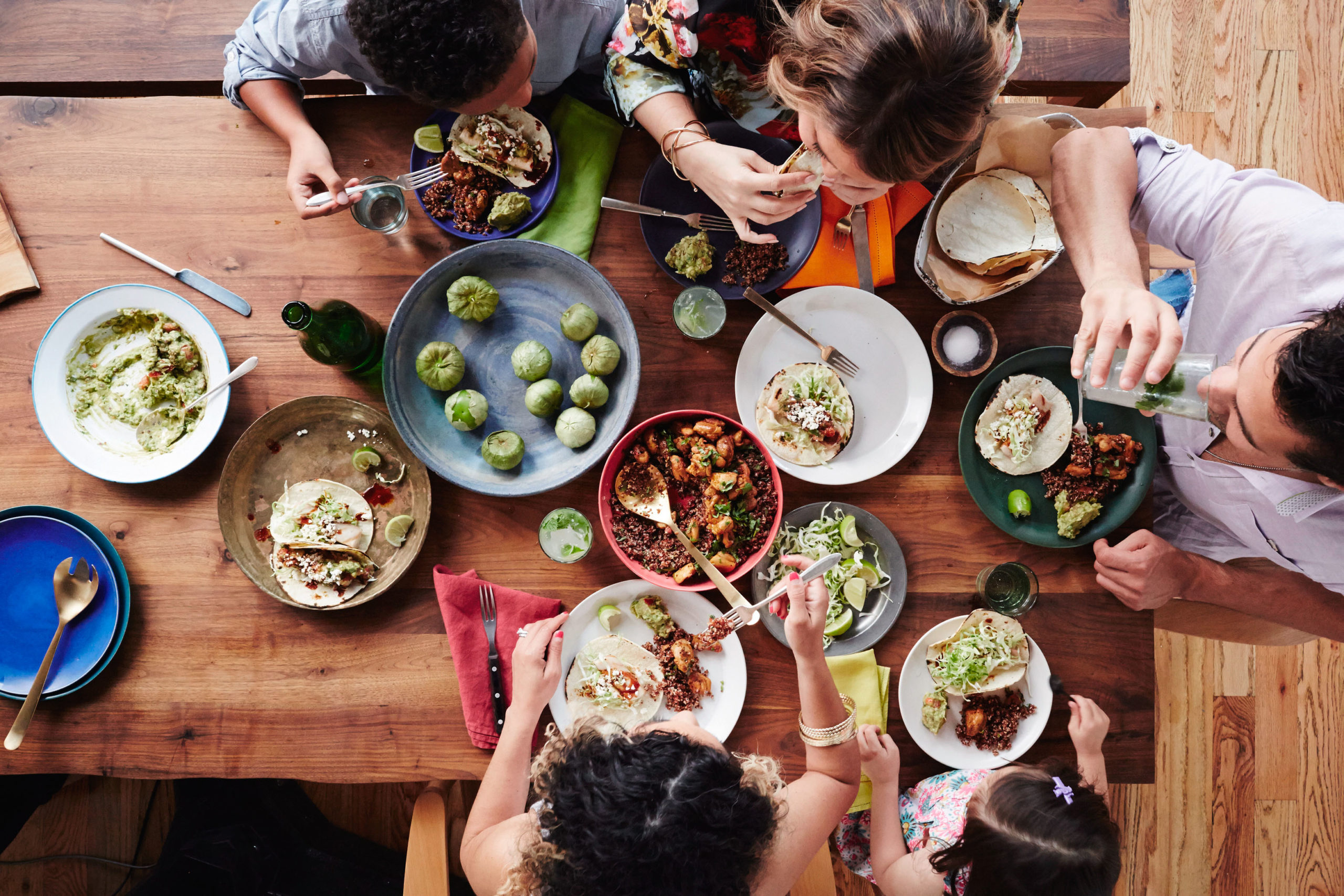
Whether you’re cooking for one, two, four, or more if you don’t have a plan it gets really hard to stick to your healthy eating goals. On top of that when you have to juggle different food preferences and the god-forbid “picky eaters” in your family, it can be downright overwhelming.
Today I want to share with you my go-to strategies for feeding myself and my family of four. My mantra is and always has been “healthy shouldn’t be hard” and this is true for feeding your family too. Let’s dive in.
Division of Responsibility
First, before we even start to talk about the food, let’s talk about what you are actually responsible for. In some ways this can be rather freeing.
My guide in this area is Ellyn Satter, Dietitian extraordinaire when it comes to feeding your family. Here’s how she breaks it down and what I strive to live by:
Grown-Ups, this is what you are responsible for:
- Deciding When, Where, and What the family is eating.
- Being a good Role Model for how to eat healthy.
Kids, this is what you are responsible for:
- Deciding how much you are going to eat and if you’re going to eat at all.
Don’t you love it? We each have a role to play and if we stick to our roles then the machine runs smoothly. Stress and resistance only come up if you try to move outside of your scope. It’s really as simple as that. Stick to what you are responsible for and let your kids have their say for what they’re responsible for. Win-win!
Let me share an example with you of how I put this into practice with my family. I decide what we’re eating each week. I sit down, I think through the week, I write out my meal plan, and I get to the store. Now, I do like to loop my kids into this process because, let’s face it, they like to have a say in what they’re eating. And I believe they should! But they should have a say in the planning and shopping phase not in the actual minutes before dinner is about to be made. So I run my ideas by the family, I ask for what they’re in the mood for, and at the store I have my kids help me pick out some veggies and fruits that look good to them this week.
Same Food For Everyone
Now, when it’s actually time for dinner, this is what goes down. I make dinner, sometimes the kiddos help me out (when they’re not trying to get their homework done), they set the table, I serve dinner, and we all sit down and eat the SAME dinner.
I do not and I NEVER recommend that you make multiple dinners for everyone’s varying food preferences. Not only is this not sustainable, it is not giving your family the right message. What is that message you might be asking? It’s this. We are in it together. We all eat the same nourishing, healing foods because our health is a priority and the food we eat is important.
From personal experience, it does not take long before your kids will get it and then actually surprise you by telling other kids that they should eat their vegetables. I actually had my daughter tell me just last night what a great mama I am because I give her good food and I don’t let her eat candy all day. 🙂
What happens when my kids don’t like everything that’s being served? No big deal. They get a little of everything on their plate and they decide what they want to eat and how much they want to eat. Now this isn’t to say I don’t encourage them to at least take a bite of everything on their plate but I NEVER make them finish what’s on their plate. That is under their control.
The opposite though is also true. If they choose not to eat, I totally respect that and I don’t make a big deal about it BUT I also remind them that they might get hungry before the next meal and I ask again just to make sure that they really don’t want anything else to eat?
This is a really important piece to this strategy. You decide when meals are served. This includes snacks. If you decide to allow your kids to snack and graze whenever they’re hungry, they really don’t have much of an incentive to eat what’s being served. This doesn’t mean I never allow my kids to have a snack but that said I don’t allow grazing all day either. I find that when my kids allow their bodies to get hungry, they anticipate the next meal, and they’re much more likely to eat what’s being offered.
Picky Eaters
So what do we do about the “picky eaters”? I know this can be a real challenge and source of stress for a lot of families. I totally get it. It’s in our DNA as parents to feed our kids. And when they’re not eating, we lose sleep at night. I’ve been there. I know how you feel.
But it’s also our responsibility to feed our kids a healthy balanced diet that’s going to help them grow and think and be strong. We have to teach our kids how to do this, especially when they’re not excited about a lot of different foods. Here’s what I suggest you try:
- Make sure every meal includes at least one item that you know they will eat.
- Get them involved in helping you plan the meals, shop for the meals, and cook the meals. They’ll have a vested interest in wanting to eat what they’ve had a hand in making.
- Plant a garden. Have them pick out some plants (veggies) they want to grow and let them care for and cultivate those plants.
- Teach your kids that they actually have to develop their taste buds. It’s totally normal for kids to prefer carbs and dairy (they ALL do). But they also need to know that unless they’re trying different foods and different flavors they’re never going to develop a taste for other foods. Our job is to help them develop a more complex palate.
- Along those lines you may even want to offer incentives for trying new foods. Perhaps they could earn a movie or a fun outing or maybe it’s even part of their chore chart. You can decide what method your child will respond to best. But please don’t make it a dessert. Bribing kids to eat their veggies with the promise of a dessert will only back-fire in the long run. We want to teach our kids to appreciate a variety of different foods not that treats and sweets are our reward every time we do something that’s hard.
- Be mindful of the fact that for some kids it can take up to 20 or more exposures to a new food before they’ll start to accept it. So stick with it. Keep offering the healthy foods and try preparing them in different ways until you find some options that your picky eater will like.
Take Home Message
Throughout this month I’m going to share with you recipes and meal ideas of some of my family’s favorite meals, kids included. But the truth is you’re going to have to work with what you and your family enjoy.
Start with the foods everyone likes and gradually bring in new and different foods. Make it an experiment for the whole family. Loop everyone in so they know what’s coming and can be part of the process. I can’t tell you all the crazy things I’ve gotten both my husband and kids to agree to eat because I looped them in and made it a family experiment.
The expectation is not that everyone will like everything they try but rather the process of actually being open to trying new things and exploring new foods. Food is a pleasure. It’s meant to be enjoyed. And there’s such a symphony of flavors waiting for you out there, so don’t get sucked into the same old favorites when there’s so much more to explore.
Ultimately that’s what you want to teach your kids. That food should be enjoyed and explored. For me, that’s the foundation of a healthy relationship with food and it sets the framework for me to be able to build healthy meals.
